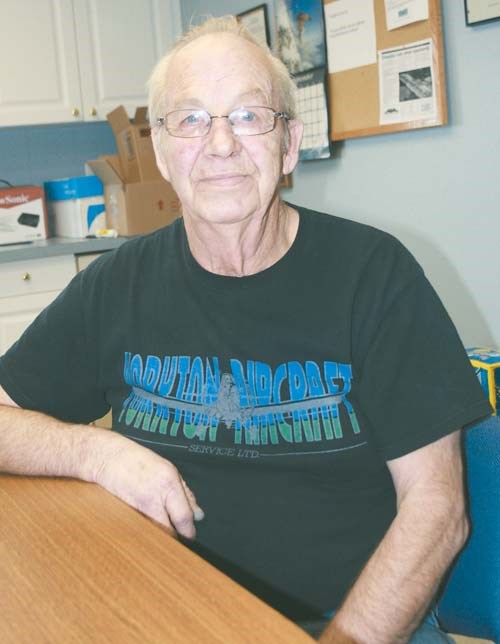A more than 50-year career in aviation maintenance and mechanics was recently recognized by the Saskatchewan Aviation Council.
Don Schnurr, who began his aviation career in Yorkton, literally criss-crossed the continent in the ensuing years, and is now back with Yorkton Air Service, received the Distinguished Airman Award which is designed to recognize and honour workers in the aviation industry. Pilots, engineers and others who have spent their working lives in the Saskatchewan Aviation Industry and have served with great distinction are eligible for the award. Individuals considered for this award may include pilots and aviation personnel: serving on scheduled airlines, flying charters, northern wilderness flying, aerial crop sprayers, aerial firefighters, air ambulance, flying farmers, pilot trainers, private pilots, engineers who have worked day and night to keep our airplanes safe.
Schnurr said the award was one he is proud of, but never expected to receive.
"It's work I enjoyed, and did it for a living," he said. " It seems very funny to get recognized for doing something you like." He said he carried on his chosen field because he liked it, not to earn recognition, noting "my wife and kids were probably happier about it than I was But if somebody gives you a plaque for something you've done over the years it's really nice."
Schnurr also credited his wife of 49-years, Barbara Ann, "for putting up with me all these years so I could accomplish all this." He added he and his wife have always been connected to aviation, having become engaged in Yorkton, then flying to Kamsack where they picked out their wedding rings.
Schnurr said he also realizes working in a shop atmosphere means he was part of a team."Everybody is at the same level," he said. " Everybody needs that extra help."
Schnurr, 69, said he began his career more than a half century ago, adding "you learn a lot along the way."
"In 1958 I started to fly and maintain airplanes," he said, recalling that when he was 16 he wanted to fly, "but I couldn't get a pilot's license until I was 17."
For Schnurr the flying bug really bit him the first time he took to the skies. He said he got his first flight with Wayne Greer.
"I enjoyed it," he said. "He let me handle the controls and handle the plane."
It was about the same time Schnurr began working for Austin Ingham at YAS. "He offered me a job at a buck an hour, eight dollars a day."
Schnurr had no formal training to start with, but found experience a good teacher.
"I started right into maintenance. I learned the tricks of the trade, how to fix things," he said, noting back then it was "a lot of fabric aircraft." He explained the fuselage and wings of aircraft where covered on Irish linen which of course required special skills to repair, adding since he knows how to do it he still gets calls to help on what are now older, vinatge, fabric-covered airplanes. " How many people know how to do fabric work, although we do quite a bit of it here."
While cutting his teeth on maintenance at the Yorkton Airport he also learned how to fly.
Schnurr said getting his license was far easier and cheaper five decades ago that it is today. He said he recalls the cost was only $385, and 30-hours of flight training to get his private pilot's license. That is considerably different now.
"The last time I heard it's $17,000, and the hours are more. You're looking at 45-hours now," he said, adding "when I had eight-hours I went solo, now you get 17-18 hours before you do."
Schnurr's actual time as a pilot was rather short-lived. A heart attack while in his 30s had his license suspended for life.
However his interest in aviation never waned, and he continued on the maintenance and mechanics side of the industry, plying his trade in a wide number of locales through the years.For example, after his initial time working in Yorkton Schnurr said he moved to Ottawa, where he had an opportunity to work on some of the most famous aircraft of the Second World War, the Lancaster and Mosquito.
"They were left over from the war. They were using them for high-level reconnaissance," he said. "They were doing a lot of mapping at that time."
Schnurr was then told he was to move to Tanzania, but his wife, who was still in Yorkton did not think that was a wise choice, so he headed back to Yorkton for a time, before taking aircraft maintenance-related jobs in Saskatoon, Buffalo Narrows, Fort McMurray and the Northwest Territories.
"It was just a matter of where the best pay was," he said. "If somebody offers you more money you go there."
In most cases Schnurr oversaw the maintenance shops as Director.
"You run the shop. You're responsible for everybody and everything that's in there," he said.Schnurr said as Director he talks with others on a crew and oversees the work which is always carefully planned and written down.
"We go to the book. Everything is laid out in the book that needs to be done," he said, adding "when something on the list is finished we go and inspect it If they (staff) have any questions the just come to you and ask."
While saying it was impossible to pick a specific airplane out as С����Ƶ special to work on, Schnurr related how he was involved in a project which took Harvards via Ray's Flying Service in Saskatoon south to be converted to look like Japanese Zeroes and used in the famous war film; Tora! Tora! Tora!
At another time he recalled doing maintenance work about as far north in Canada as you can get."I've been 50-miles from the North Pole fixing an airplane," said Schnurr, adding it was "minus-47 below."

.png;w=120;h=80;mode=crop)


